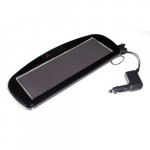Like many people I have a caravan which is used frequently in summer but is stored in winter.
The leisure battery fitted in the caravan is 12 volt 110 Amp/Hour. These type of batteries do not fare well
if left for months on end in the cold without being either charged or discharged. Over the years I have had
a couple of batteries fail. I now keep them in my garage over the winter months.
I now have the time to build some form of battery conditioner that will charge and discharge the battery
whilst it is sat on the bench in the garage. My question is what is the most suitable system of keeping the
battery in tip top condition.
My initial thoughts are to use a Picaxe to monitor the battery voltage and
switch in a battery charger when a low of say 11.5v is reached and off again when the battery voltage
is back up to say 12.8 volts (as an example). The battery is then discharged via a load (possibly a car bulb), and so on.
There are plenty of battery charging circuits on the web but I do not know enough about the subject to
determine which is best and at what voltages should switchover occur. Also what level of current is suitable
and what are the best methods of fixing the charge/discharge current levels.
Many thanks for your help
Clockwork.
The leisure battery fitted in the caravan is 12 volt 110 Amp/Hour. These type of batteries do not fare well
if left for months on end in the cold without being either charged or discharged. Over the years I have had
a couple of batteries fail. I now keep them in my garage over the winter months.
I now have the time to build some form of battery conditioner that will charge and discharge the battery
whilst it is sat on the bench in the garage. My question is what is the most suitable system of keeping the
battery in tip top condition.
My initial thoughts are to use a Picaxe to monitor the battery voltage and
switch in a battery charger when a low of say 11.5v is reached and off again when the battery voltage
is back up to say 12.8 volts (as an example). The battery is then discharged via a load (possibly a car bulb), and so on.
There are plenty of battery charging circuits on the web but I do not know enough about the subject to
determine which is best and at what voltages should switchover occur. Also what level of current is suitable
and what are the best methods of fixing the charge/discharge current levels.
Many thanks for your help
Clockwork.

